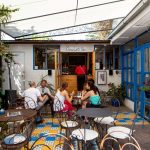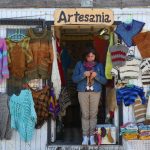Passage in Time, Santiago Old and New
People who visit Santiago often comment that while it seems like parts of the city are very old, other parts are surprisingly modern. We like the contrast, and think you will, too, which is why we’ve put together this list of some older and newer neighborhoods that you can mix and match as you like over the course of your stay.
Yesteryear
There are a few important historical points you could start at to get to know a little bit about old Santiago. Three suggestions are the centrally-located Cerro Santa Lucía, Plaza de Armas, or across the river, the Mercado Central and the Cementerio General. See below for more detail.
Cerro Santa Lucía
Santiago was founded in 1541 at the foot of what is now Cerro Santa Lucía, by Pedro de Valdivia. A walk up here will give you a (low-flying) birds’ eye view of the city, and there are several little plazas and look out points, as well as lots of green on this little backyard to the historical Lastarria neighborhood. Just across the street and a bit further east is oldest remaining wall remaining in the city on the north side of the San Francisco church. The former convent has been converted to the Museo Colonial de San Francisco, one of Chile’s finest collections of colonial and religious art. Inside is a shaded garden, which peacocks occasionally wander. If you’re all about architecture, continue south on San Francisco to the corner of where the streets os Paris and Londres meet. Here is one of the city’s oldest cobblestoned neighborhoods, which has not been turned into a gastronomical hub, as has its better-known twin of Lastarria.
Plaza de Armas
When Pedro de Valdivia came to Chile, he established the original grid of the city, which included the Plaza de Armas, where there is a large statue of him on a horse at the north east corner, a common meeting point for Santiaguinos. Nearby, on the ground in bronze is a metal map showing the original layout of the city. Surrounding this plaza are the Museo Histórico Nacional, the main post office, and the Cathedral. Also flanking the plaza is the lively Portal Fernandez Concha, an interior colonnade on the first floor of the building on the south side that houses many informal eateries, including Quick Lunch Bahamondes, which is said to be the birthplace of the Chilean completo, a Chilean-style hot dog that comes with avocado, tomatoes and mayonnaise on top.
Mercado Central and Recoleta
Walking from Plaza de Armas further north, towards the river, you come upon the bustle of what was historically called “La Chimba,” and which is now a major commerce area for food, from meat and vegetables to dry goods stores called tostadurias, where mostly nuts, flours, dried fruit and grains are sold. This area is also where the historical Mercado Central is located, a masonry building with a beautiful wrought iron structure (visible from inside) that was completed in 1872. Stop for lunch, or just to take a peek. From here, it’s a quick metro or taxi ride to Cementerios, the metro stop that takes you to the Cementerio General, one of the largest cemeteries in Latin America, which was established in 1821. In addition to nearly all of the deceased former presidents being buried there (Augusto Pinochet being a notable exception), more than a hundred important historical and folk figures are also buried here. There are many different sections including modern graves, a memorial commemorating the disappeared from the dictatorship, as well as many decorative, historical above-ground mausoleums and statues.
Modern Day
After you’ve had your fill of Santiago’s yesteryear, or in between visits to some of these sights or some of the other neighborhoods worth a wander it makes an interesting contrast to head uptown, to the newer, eastern parts of the city, where wider, more modern streets and glassed in buildings give the city a totally different feel. Three places you might want to check out to get that contrast are the eastern part of Providencia, the western part of Las Condes, and Vitacura.
Eastern Providencia
Providencia is one of Santiago’s 37 comunas, or urban subdivisions, and the eastern part of it is the newest and it includes the Gran Costanera Torre, a 64-story glass tower that is visible from most of the city. It was completed in 2013, and is the tallest building in South America, and the second tallest in the southern hemisphere. Of interest in the Costanera are two main attractions, the four-story mall at the bottom, and Sky Costanera at the top. Sky Costanera is a paid observation deck that opened in 2015 and is located on the 61st and 62nd floors. On clear days, the 360-degree view is unforgettable, both over the city and with clear views of the snow-topped Andes to the east.
El Golf
The area just to the west of the Costanera Tower is where the comuna of Las Condes begins. This area has a skyline unlike any other part of Santiago, and locals think it is reminiscent of Manhattan, which gives it its nickname of Sanhattan. Buildings house mostly businesses and the occasional hotel, with some ground-floor commerce, but with broad avenues and sidewalks that make walking here a pleasure. Just to the north is the fashionable artery of Isidora Goyenechea, where most of the restaurants and cafés in this neighborhood are concentrated. Isidora—as we call it—is worth a stroll, especially around lunch or dinnertime.
Vitacura
The two streets of Alonso de Córdova and Nueva Costanera are where most of the shops, high-end restaurants and galleries are located within the wealthy comuna of Vitacura. Alónso de Córdova, traverses the main street of Vitacura, but most of the activity takes place to the north side. There are many shops, boutiques and galleries, with clothing, furniture and design items. Nearby the street of Nueva Costanera has very highly regarded and award-winning restaurants such as Boragó (LINK TO TOP 50 piece), La Mar, Rubaiyat and Ox, and newly, one of the most upscale shopping centers in the country, Casa Costanera. Where the street Nueva Costanera ends, there is Vitacura’s Parque Bicentenario a huge, family-friendly park with a couple of food trucks, fantastic play structures for kids, one large restaurant and a koi pond and a few waterfowl ponds, one of which is populated by flamingoes. The park is a popular place on weekends, and on weekdays in the morning and evening athletes take advantage of the open green space and a few running and bicycling trails. At Christmas time they set up a larger-than-life nativity scene on the park’s tallest hill.

